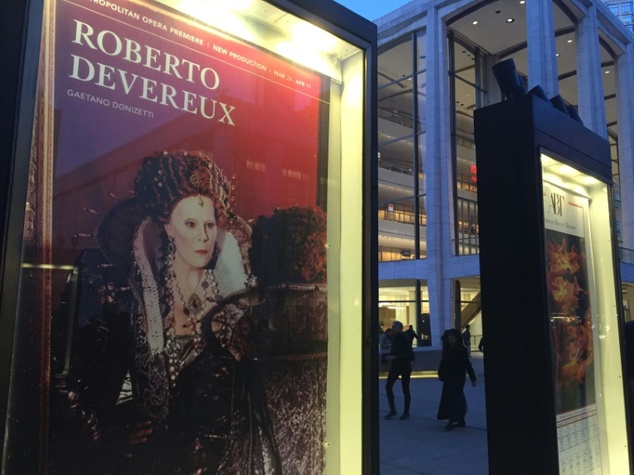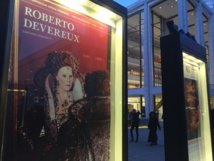Elizabeth makes a cameo as the petite red-haired daughter of Anne Boleyn in "Anna Bolena," a spite- and betrayal-filled melodrama that concludes with the title character getting beheaded after she is charged with adultery and conspiracy against the king.
Elizabeth comes back with a vengeance in "Maria Stuarda," which features one of opera's most in-your-face confrontation scenes between Elizabeth and Mary Stuart, Queen of Scots. At the end, Maria is sent to the gallows after Elizabeth signs her death warrant.
In "Roberto Devereux," Elizabeth, old and bitter at having given her life to duty of the crown above all else, signs the death warrant of the much-younger title character, whose unrequited love sends the queen reeling. The opera and the trilogy crescendos in a mad scene featuring a distraught Elizabeth as Roberto is executed.
Saturday's performance of "Roberto Devereux" marks the culmination of a years-long Met quest to present all three operas in a single season, sung by the same person, the powerhouse soprano Sondra Radvanovsky.
This feat was last done in New York in the 1970s by Beverly Sills at the New York City Opera in a pursuit that landed the singer on the cover of Time magazine.
Donizetti wrote the roles for different singers when the operas premiered in Italy between 1830 and 1837. Experts in Donizetti, whose best-known works include the tragic "Lucia di Lammermoor" and the comic "L'Elisir d'Amore," are not aware of any other singers until Radvanovksy who have performed the trilogy in quick succession, either before or after Sills.
- In search of 'excitement' -
"Opera needs excitement," said Met general manager Peter Gelb, who spearheaded the project shortly after taking the helm at the prestigious opera house a decade ago.
The push is part of Gelb's effort to keep opera relevant in a society increasingly dominated by smartphones and newer music forms, such as hip-hop.
"We're always looking for new threads that will excite the public," Gelb told AFP. "Making opera interesting in the 21st century requires finding connections with other areas."
Gelb was pleased that Saturday's matinee of "Roberto Devereux" had essentially sold out. Ticket sales in 2015-16 for the first two installments were not as strong, which is typical of most revivals.
"Artistically it's exceeded expectations," he said. "From a box office point of view, it has more or less met expectations."
The Met's introduction of the operas into the repertory has come as tales about British royalty and the Tudors have been a hot act in New York theater, as reflected by the "Wolf Hall" Broadway plays and other shows.
Gelb initially envisioned the project as a vehicle for star Russian soprano Anna Netrebko, who debuted "Anna Bolena" to open the 2011-12 Met season but opted against doing all three parts. She was followed for the second installment by the star American mezzo-soprano Joyce DiDonato, who premiered Maria Stuarda on New Year's Eve in 2012.
After Netrebko backed off, Gelb turned to Radvanovksy, an American singer with vast range.
At the premiere of "Roberto Devereux" last month, Radvanovksy, previously known for well-known roles such as Puccini's "Tosca," drew thunderous ovations, particularly for her rendition of the final mad-scene aria when Elizabeth staggers across the stage.
- Historical liberties -
Of course, Elizabethan sticklers will note that there is no evidence that the Virgin Queen ever suffered such an infamous meltdown, just as Mary Stuart never called Elizabeth "vil bastardo,"or "vile bastard,"to her face, a highpoint in "Maria Stuarda."
Such liberties were commonplace in theater and opera until very recently, said Susan Rutherford, senior lecturer of music at the University of Manchester.
"History offers a way of reading the past," she said. "You can twist it towards the story you actually want to tell."
Experts in Donizetti's oeuvre say the Tudor trilogy, first presented about 20 years before Verdi masterpieces such as "La Traviata," reflected Italy's fascination with Britain and Scotland apparent in widely translated works by Sir Walter Scott and others.
The not-especially-flattering depiction of the royals was also in keeping with a growing tilt against monarchy.
The operas "were a way of critiquing an absolute monarch, but in a way that was safe," said Mary Ann Smart, a professor of music scholarship at the University of California, Berkeley, noting that Donizetti wrote operas on commission for the King of Naples.
"It wasn't going to be seen as a critique of, say, the King of Naples."
---------------------------------------------------------------------------------------------------------------
Elizabeth comes back with a vengeance in "Maria Stuarda," which features one of opera's most in-your-face confrontation scenes between Elizabeth and Mary Stuart, Queen of Scots. At the end, Maria is sent to the gallows after Elizabeth signs her death warrant.
In "Roberto Devereux," Elizabeth, old and bitter at having given her life to duty of the crown above all else, signs the death warrant of the much-younger title character, whose unrequited love sends the queen reeling. The opera and the trilogy crescendos in a mad scene featuring a distraught Elizabeth as Roberto is executed.
Saturday's performance of "Roberto Devereux" marks the culmination of a years-long Met quest to present all three operas in a single season, sung by the same person, the powerhouse soprano Sondra Radvanovsky.
This feat was last done in New York in the 1970s by Beverly Sills at the New York City Opera in a pursuit that landed the singer on the cover of Time magazine.
Donizetti wrote the roles for different singers when the operas premiered in Italy between 1830 and 1837. Experts in Donizetti, whose best-known works include the tragic "Lucia di Lammermoor" and the comic "L'Elisir d'Amore," are not aware of any other singers until Radvanovksy who have performed the trilogy in quick succession, either before or after Sills.
- In search of 'excitement' -
"Opera needs excitement," said Met general manager Peter Gelb, who spearheaded the project shortly after taking the helm at the prestigious opera house a decade ago.
The push is part of Gelb's effort to keep opera relevant in a society increasingly dominated by smartphones and newer music forms, such as hip-hop.
"We're always looking for new threads that will excite the public," Gelb told AFP. "Making opera interesting in the 21st century requires finding connections with other areas."
Gelb was pleased that Saturday's matinee of "Roberto Devereux" had essentially sold out. Ticket sales in 2015-16 for the first two installments were not as strong, which is typical of most revivals.
"Artistically it's exceeded expectations," he said. "From a box office point of view, it has more or less met expectations."
The Met's introduction of the operas into the repertory has come as tales about British royalty and the Tudors have been a hot act in New York theater, as reflected by the "Wolf Hall" Broadway plays and other shows.
Gelb initially envisioned the project as a vehicle for star Russian soprano Anna Netrebko, who debuted "Anna Bolena" to open the 2011-12 Met season but opted against doing all three parts. She was followed for the second installment by the star American mezzo-soprano Joyce DiDonato, who premiered Maria Stuarda on New Year's Eve in 2012.
After Netrebko backed off, Gelb turned to Radvanovksy, an American singer with vast range.
At the premiere of "Roberto Devereux" last month, Radvanovksy, previously known for well-known roles such as Puccini's "Tosca," drew thunderous ovations, particularly for her rendition of the final mad-scene aria when Elizabeth staggers across the stage.
- Historical liberties -
Of course, Elizabethan sticklers will note that there is no evidence that the Virgin Queen ever suffered such an infamous meltdown, just as Mary Stuart never called Elizabeth "vil bastardo,"or "vile bastard,"to her face, a highpoint in "Maria Stuarda."
Such liberties were commonplace in theater and opera until very recently, said Susan Rutherford, senior lecturer of music at the University of Manchester.
"History offers a way of reading the past," she said. "You can twist it towards the story you actually want to tell."
Experts in Donizetti's oeuvre say the Tudor trilogy, first presented about 20 years before Verdi masterpieces such as "La Traviata," reflected Italy's fascination with Britain and Scotland apparent in widely translated works by Sir Walter Scott and others.
The not-especially-flattering depiction of the royals was also in keeping with a growing tilt against monarchy.
The operas "were a way of critiquing an absolute monarch, but in a way that was safe," said Mary Ann Smart, a professor of music scholarship at the University of California, Berkeley, noting that Donizetti wrote operas on commission for the King of Naples.
"It wasn't going to be seen as a critique of, say, the King of Naples."
---------------------------------------------------------------------------------------------------------------









 Home
Home Politics
Politics











